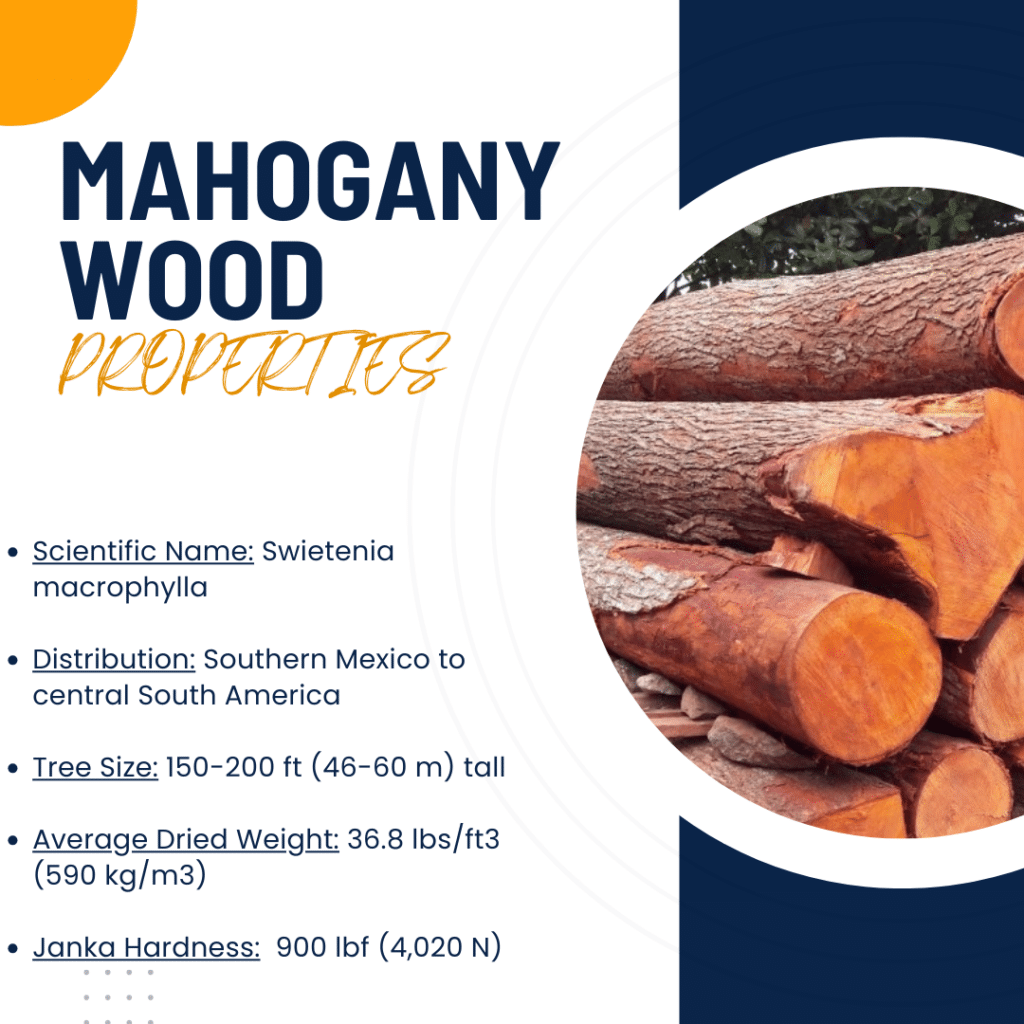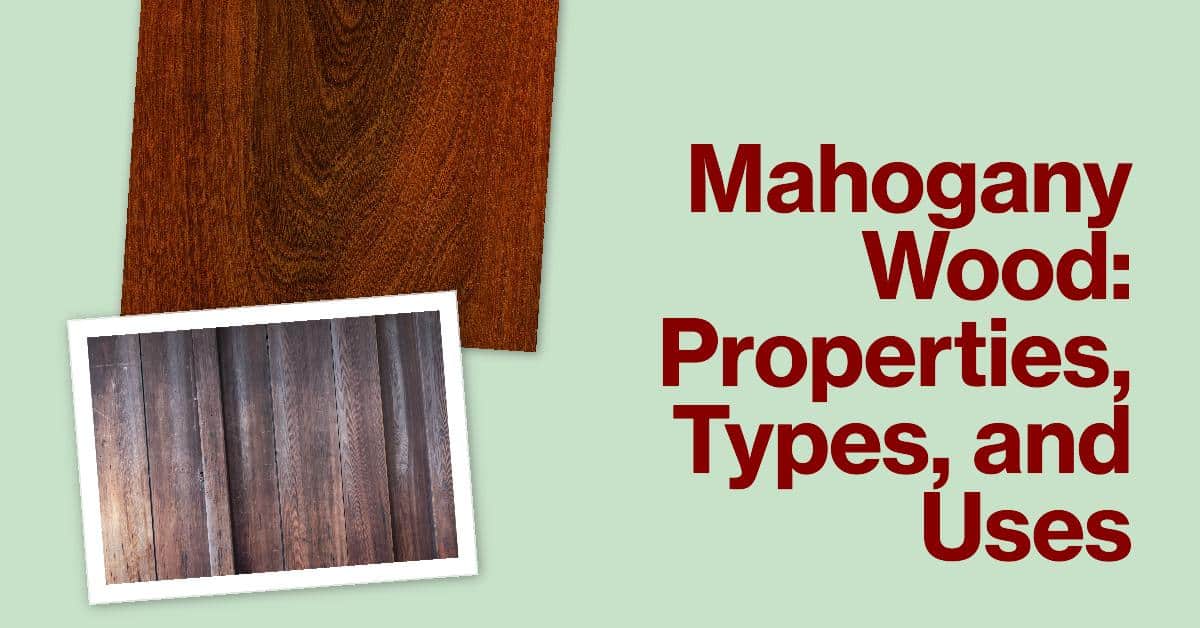With its warm tones, graceful grain patterns, and enduring strength, mahogany wood is one of the most widely used lumber among woodworkers. Its rich hues and straight-grain patterns make it a popular choice for furniture making. However, not all mahogany is the same, in this comprehensive guide, we will explore the different types of mahogany wood, their properties, and how they are commonly used.
About Mahogany Wood
It is a common hardwood from various Genus Swietenia, Khaya, or Entandrophragma species. These trees are native to tropical regions such as Africa, South America, and Southeast Asia. It is one of the easiest woods to work with and is popularly known for its rich reddish-brown color, smooth texture, and strength. People like to use mahogany wood to make furniture, flooring, and decorative items because it looks beautiful and lasts a long time.
Common Properties of Mahogany Wood

| Common Name(s) | Honduran mahogany, big-leaf mahogany, Brazilian/American mahogany |
| Scientific Name | Swietenia macrophylla |
| Distribution | Southern Mexico to Central South America |
| Tree Size | 150-200 ft (46-60 m) tall, 3-6 ft (1-2 m) trunk diameter |
| Average Dried Weight | 36.8 lbs/ft3 (590 kg/m3) |
| Specific Gravity (Basic, 12% MC) | 0.52, 0.59 |
| Janka Hardness | 900 lbf (4020 N) |
| Modulus of Rupture | 80.8 MPa |
| Elastic Modulus | 10.06 GPa |
| Crushing Strength | 46.6 MPa |
| Shrinkage | Radial: 2.9%, Tangential: 4.3%, Volumetric: 7.5%, T/R Ratio: 1.5 |
Other Important Properties of Mahogany Wood
Color: It typically ranges from reddish-brown to pinkish hues.
Grain: It has a straight interlocking grain pattern that contributes to its distinctive appearance.
Density: Mahogany is a dense hardwood with good strength and durability.
Workability: It is relatively easy to work with, using hand and machine tools, making it suitable for various woodworking projects.
Popular Types of Mahogany Wood
1. Genuine Mahogany (Swietenia genus)
Popularly known as Honduran or American mahogany, it comes primarily from Central and South America. With a Janka hardness of approximately 800-900 lbf, it offers moderate durability and is resistant to decay and rot. Its notable workability allows for easy cutting, sanding, and finishing, making it favored by craftsmen for intricate designs.
Common Uses: furniture, cabinetry, and musical instruments
2. African Mahogany (Khaya genus)
African mahogany is harvested from several species within the Khaya genus, commonly found in West and Central Africa. It features a reddish-brown to pinkish hue with interlocking grain patterns and boasts a decent Janka hardness of 830 to 1070 pounds-force (lbf), it strikes a good balance between durability and workability, making it suitable for different woodworking projects. Moreover, it is popular for its stability, durability, and resistance to decay.
Common Uses: furniture making, boat building, and decorative veneers
3. Philippine Mahogany (Lauan)
Philippine Mahogany, also known as Lauan, doesn’t belong to the Swietenia genus but is commonly referred to as mahogany because of many similarities. It’s sourced from trees in Southeast Asia, particularly the Philippines. It features a light to medium brown color with a straight grain, offering a clean and uniform appearance. The Janka hardness ranges from 600 to 800 pounds-force (lbf), it’s relatively soft, making it easy to work with but less durable than other mahogany species. Despite its softer nature, it provides decent resistance to decay and rot when properly treated.
Common Uses: plywood manufacturing, interior paneling, and inexpensive furniture
4. Sapele Mahogany (Entandrophragma cylindricum)
It originates from West Africa, primarily Nigeria, Cameroon, and the Ivory Coast. It features a darker reddish-brown color compared to other species, often with a ribbon-like grain pattern. Its Janka hardness is quite high and ranges from 1410 to 1510 pounds-force (lbf), it’s notably durable and resistant to wear, making it suitable for indoor and outdoor use.
Common Uses: boat building, flooring, and high-end cabinetry.
5. Spanish Cedar (Cedrela odorata)
While not technically a mahogany species, Spanish Cedar is often grouped with mahogany due to its similar appearance and properties. It features a reddish-brown color with a straight grain. It is commonly used in outdoor applications due to its resistance to decay and insects
Common Uses: closet linings and outdoor furniture
6. Utile/Sipo (Entandrophragma utile)
Utile, also known as Sipo, is not technically a type of mahogany. While its characteristics have much in common with certain species, such as a reddish-brown color and interlocked grain pattern, it belongs to the Entandrophragma genus, distinct from the Swietenia, Khaya, and other genera typically associated with mahogany.
Common Uses: furniture, cabinetry, flooring, and boat building
Which is the Best Quality Mahogany?
Various factors must be considered in determining the best quality mahogany, including properties, availability, and intended use. While each species offers unique characteristics, Genuine Mahogany (Swietenia genus) is often the top choice for its superior quality and desirable attributes. However, it’s essential to weigh the pros and cons of mahogany wood to make an informed decision.

